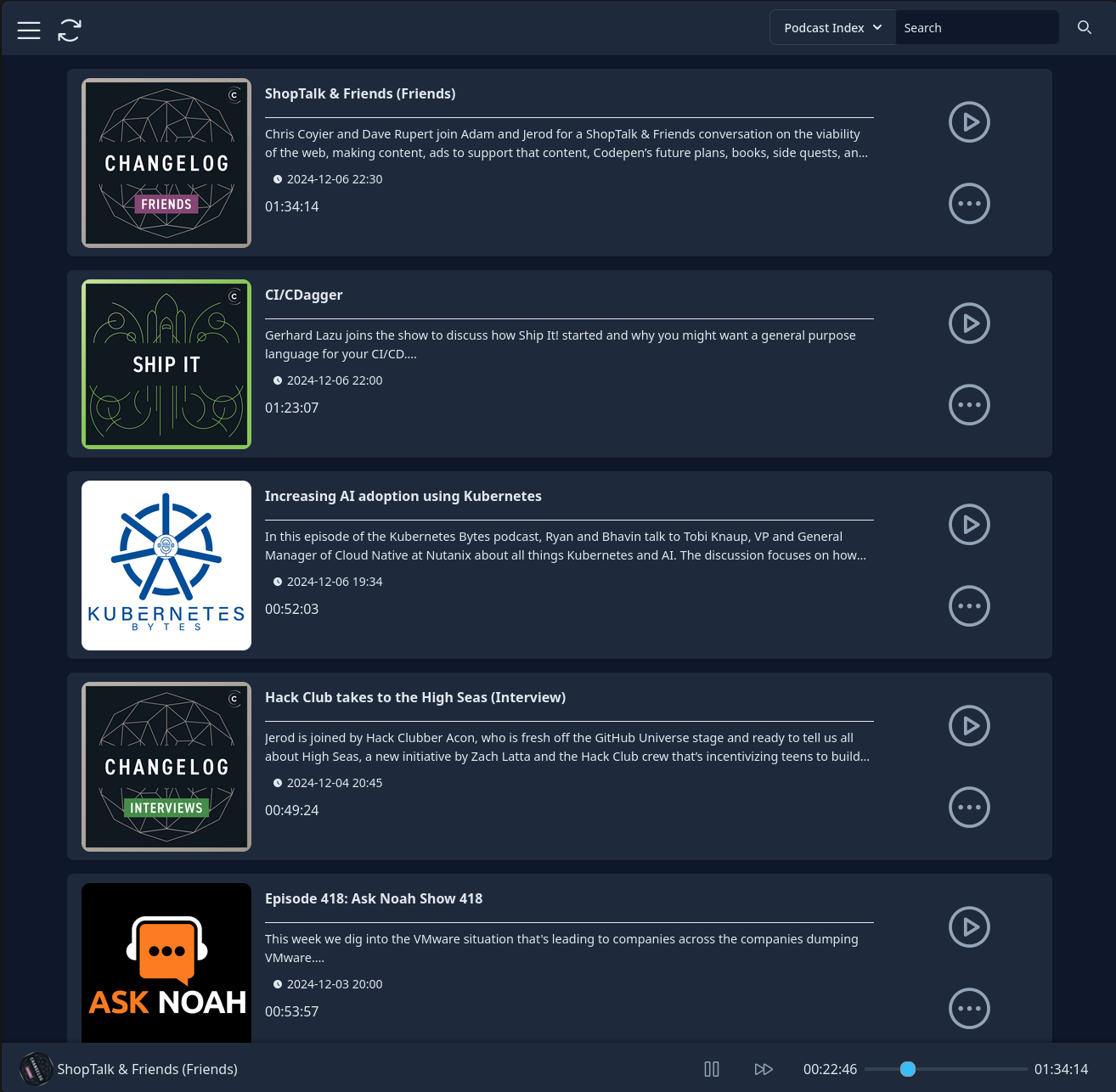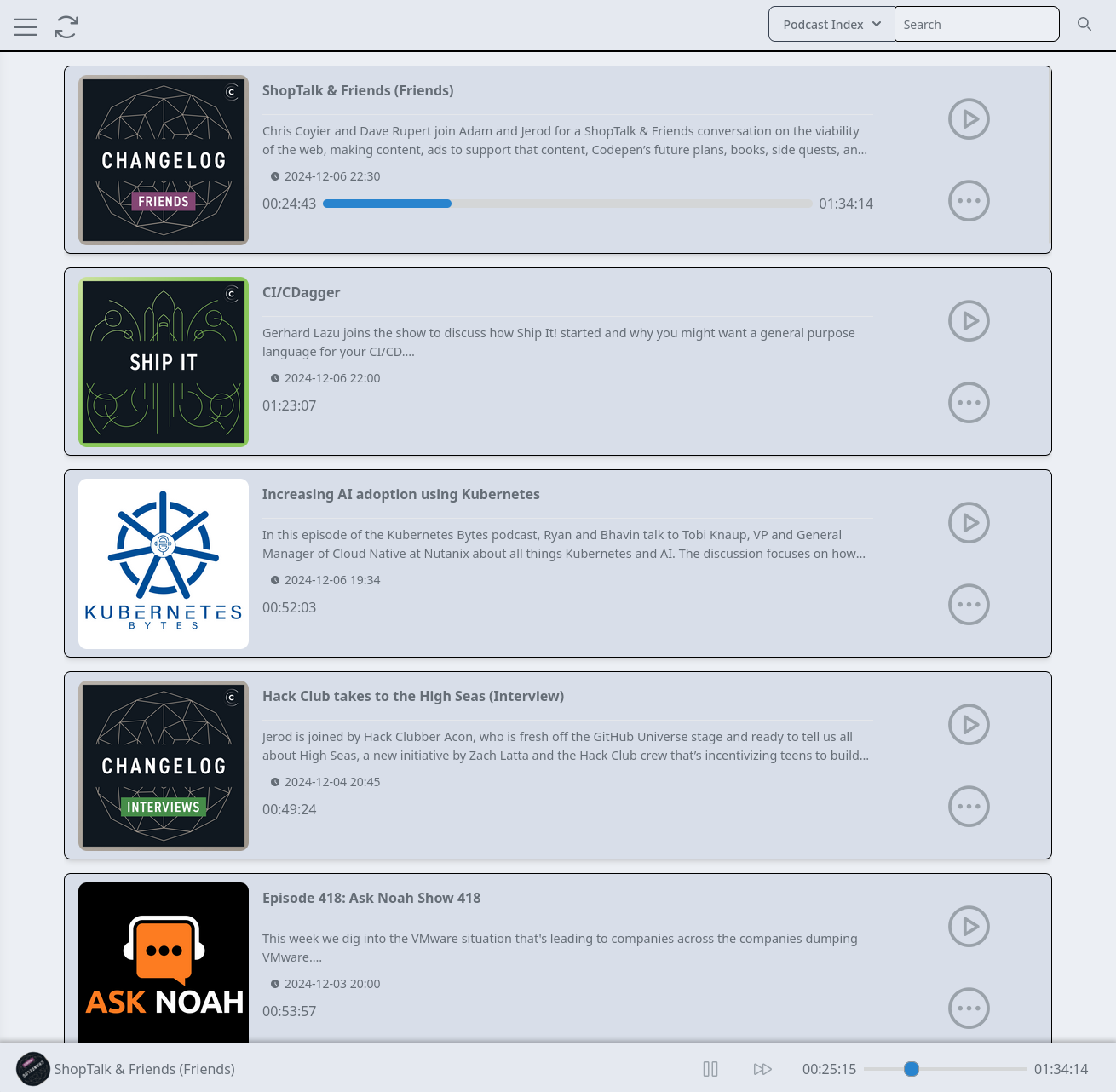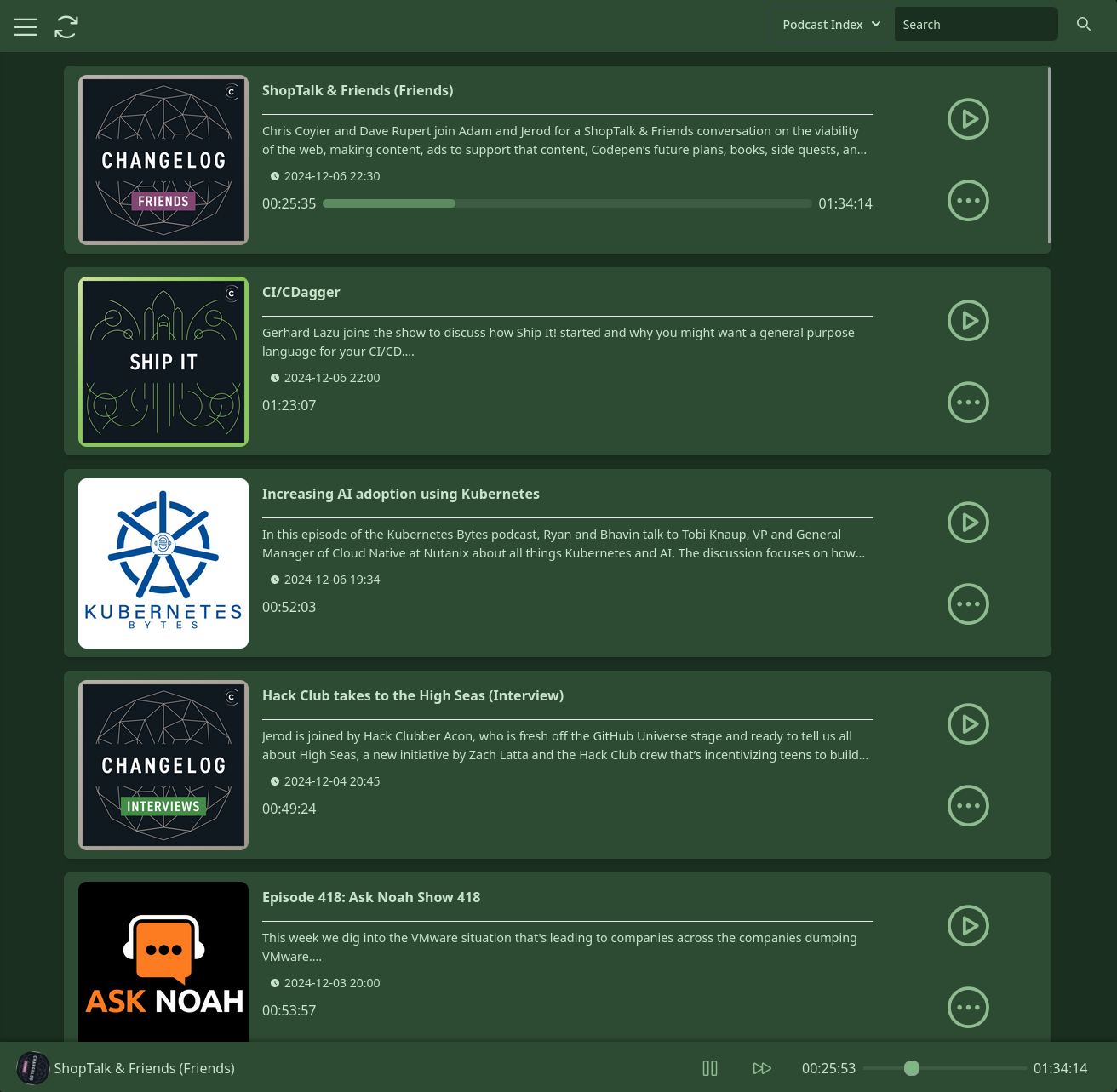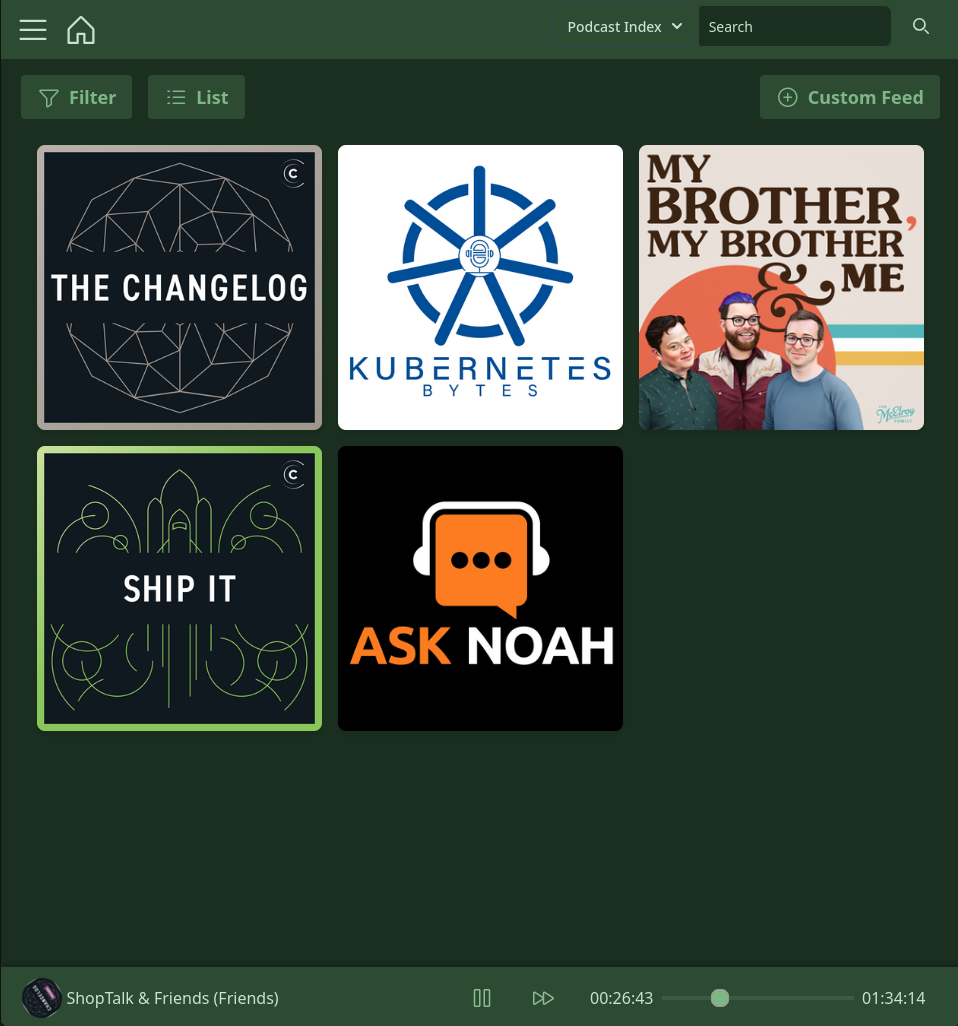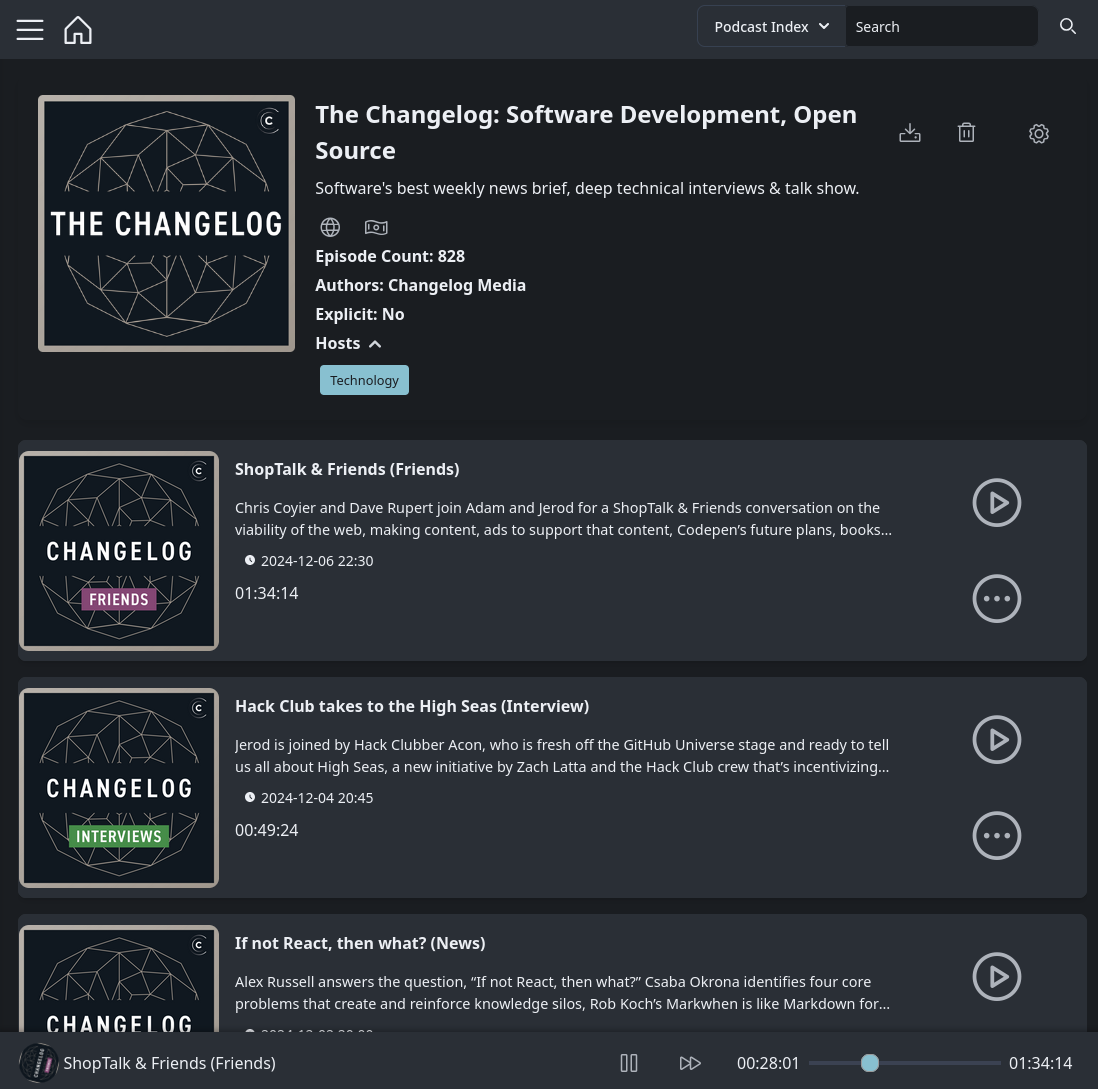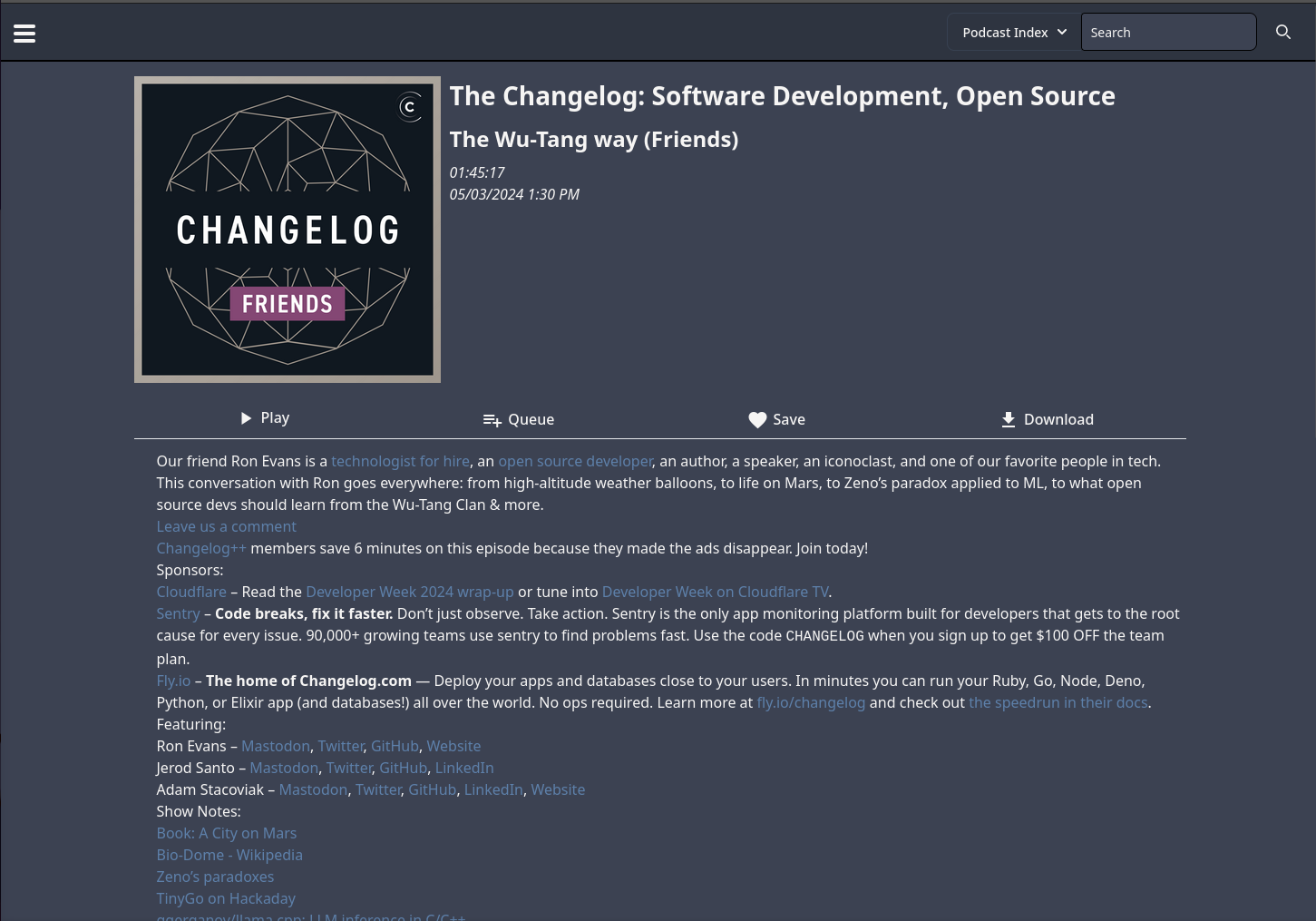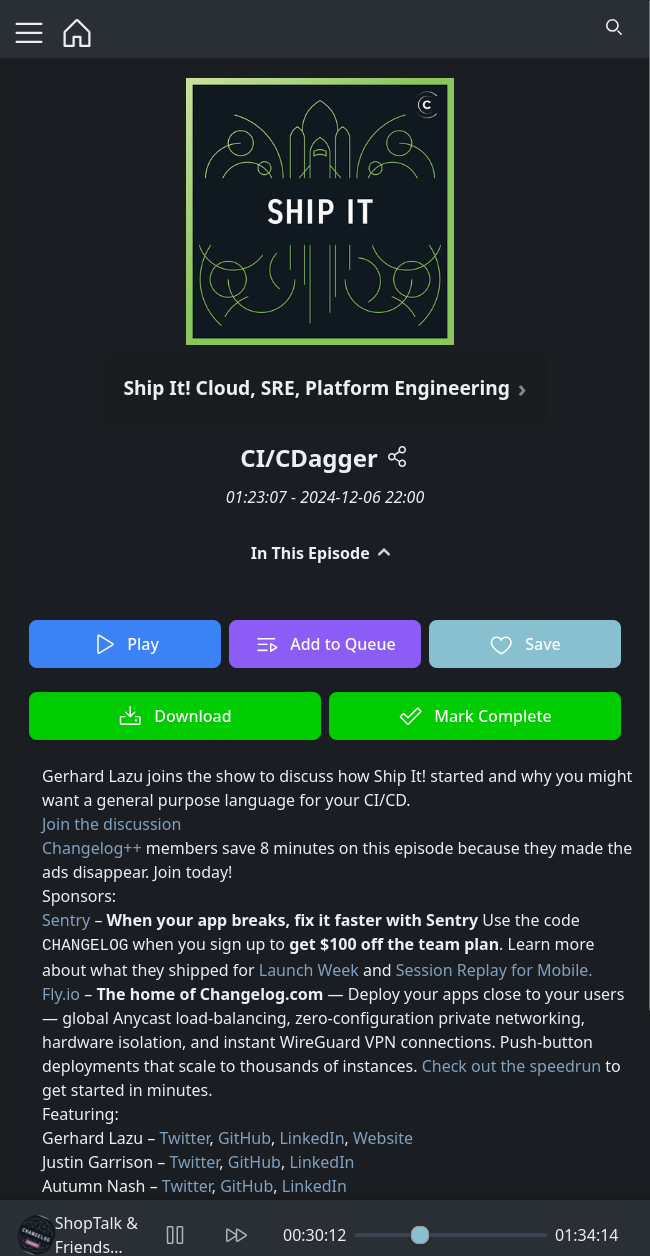- PinePods 🌲
- Getting Started
PinePods is a Rust based podcast management system that manages podcasts with multi-user support and relies on a central database with clients to connect to it. It's browser based and your podcasts and settings follow you from device to device due to everything being stored on the server. You can subscribe to podcasts and even hosts for podcasts with the help of the PodPeopleDB. It works on mobile devices and can also sync with a Nextcloud server or gpodder compatible sync server so you can use external apps like Antennapod as well!
For more information than what's provided in this repo visit the documentation site.
Pinepods is a complete podcast management system and allows you to play, download, and keep track of podcasts you (or any of your users) enjoy. It allows for searching and subscribing to hosts and podcasts using The Podcast Index or Itunes and provides a modern looking UI to browse through shows and episodes. In addition, Pinepods provides simple user management and can be used by multiple users at once using a browser or app version. Everything is saved into a MySQL or Postgres database including user settings, podcasts and episodes. It's fully self-hosted, open-sourced, and I provide an option to use a hosted search API or you can also get one from the Podcast Index and use your own. There's even many different themes to choose from! Everything is fully dockerized and I provide a simple guide found below explaining how to install and run Pinepods on your own system.
I maintain an instance of Pinepods that's publicly accessible for testing over at try.pinepods.online. Feel free to make an account there and try it out before making your own server instance. This is not intended as a permanent method of using Pinepods and it's expected you run your own server; accounts will often be deleted from there.
There's potentially a few steps to getting Pinepods fully installed. After you get your server up and running fully you can also install the client editions of your choice. The server install of Pinepods runs a server and a browser client over a port of your choice in order to be accessible on the web. With the client installs you simply give the client your server url to connect to the database and then sign in.
First, the server. You have multiple options for deploying Pinepods:
You can also choose to use MySQL/MariaDB or Postgres as your database. Examples for both are provided below.
services:
db:
container_name: db
image: postgres:latest
environment:
POSTGRES_DB: pinepods_database
POSTGRES_USER: postgres
POSTGRES_PASSWORD: myS3curepass
PGDATA: /var/lib/postgresql/data/pgdata
volumes:
- /home/user/pinepods/pgdata:/var/lib/postgresql/data
ports:
- "5432:5432"
restart: always
valkey:
image: valkey/valkey:8-alpine
ports:
- "6379:6379"
pinepods:
image: madeofpendletonwool/pinepods:latest
ports:
- "8040:8040"
environment:
# Basic Server Info
SEARCH_API_URL: 'https://search.pinepods.online/api/search'
PEOPLE_API_URL: 'https://people.pinepods.online'
# Database Vars
DB_TYPE: postgresql
DB_HOST: db
DB_PORT: 5432
DB_USER: postgres
DB_PASSWORD: myS3curepass
DB_NAME: pinepods_database
# Valkey Settings
VALKEY_HOST: valkey
VALKEY_PORT: 6379
# Enable or Disable Debug Mode for additional Printing
DEBUG_MODE: false
volumes:
# Mount the download and backup locations on the server
- /home/user/pinepods/downloads:/opt/pinepods/downloads
- /home/user/pinepods/backups:/opt/pinepods/backups
depends_on:
- db
- valkeyservices:
db:
container_name: db
image: mariadb:latest
command: --wait_timeout=1800
environment:
MYSQL_TCP_PORT: 3306
MYSQL_ROOT_PASSWORD: myS3curepass
MYSQL_DATABASE: pinepods_database
MYSQL_COLLATION_SERVER: utf8mb4_unicode_ci
MYSQL_CHARACTER_SET_SERVER: utf8mb4
MYSQL_INIT_CONNECT: 'SET @@GLOBAL.max_allowed_packet=64*1024*1024;'
volumes:
- /home/user/pinepods/sql:/var/lib/mysql
ports:
- "3306:3306"
restart: always
valkey:
image: valkey/valkey:8-alpine
ports:
- "6379:6379"
pinepods:
image: madeofpendletonwool/pinepods:latest
ports:
- "8040:8040"
environment:
# Basic Server Info
SEARCH_API_URL: 'https://search.pinepods.online/api/search'
PEOPLE_API_URL: 'https://people.pinepods.online'
# Database Vars
DB_TYPE: mariadb
DB_HOST: db
DB_PORT: 3306
DB_USER: root
DB_PASSWORD: myS3curepass
DB_NAME: pinepods_database
# Valkey Settings
VALKEY_HOST: valkey
VALKEY_PORT: 6379
# Enable or Disable Debug Mode for additional Printing
DEBUG_MODE: false
volumes:
# Mount the download and backup locations on the server
- /home/user/pinepods/downloads:/opt/pinepods/downloads
- /home/user/pinepods/backups:/opt/pinepods/backups
depends_on:
- db
- valkeyMake sure you change these variables to variables specific to yourself at a minimum.
# These next 4 are optional. They allow you to set an admin without setting on the first boot
USERNAME: pinepods
PASSWORD: password
FULLNAME: John Pinepods
EMAIL: john@pinepods.com
# DB vars should match your values for the db you set up above
DB_TYPE: postgresql
DB_HOST: db
DB_PORT: 5432
DB_USER: postgres
DB_PASSWORD: myS3curepass
DB_NAME: pinepods_database
Most of those are pretty obvious, but let's break a couple of them down.
First of all, the USERNAME, PASSWORD, FULLNAME, and EMAIL vars are your details for your default admin account. This account will have admin credentails and will be able to log in right when you start up the app. Once started you'll be able to create more users and even more admins but you need an account to kick things off on. If you don't specify credentials in the compose file it will create an account with a random password for you but I would recommend just creating one for yourself.
Let's talk quickly about the searching API. This allows you to search for new podcasts and it queries either itunes or the podcast index for new podcasts. The podcast index requires an api key while itunes does not. If you'd rather not mess with the api at all simply set the API_URL to the one below.
SEARCH_API_URL: 'https://search.pinepods.online/api/search'
Above is an api that I maintain. I do not guarantee 100% uptime on this api though, it should be up most of the time besides a random internet or power outage here or there. A better idea though, and what I would honestly recommend is to maintain your own api. It's super easy. Check out the API docs for more information on doing this. Link Below -
https://www.pinepods.online/docs/API/search_api
Either way, once you have everything all setup and your compose file created go ahead and run
sudo docker-compose up
To pull the container images and get started. Once fully started up you'll be able to access pinepods at the port you configured and you'll be able to start connecting clients as well.
Alternatively, you can deploy Pinepods using Helm on a Kubernetes cluster. Helm is a package manager for Kubernetes that simplifies deployment. Adding the Helm Repository
First, add the Pinepods Helm repository:
helm repo add pinepods http://helm.pinepods.online/PinePods
helm repo update
To install the Pinepods Helm chart, run:
helm install pinepods pinepods/pinepods -f my-values.yaml --namespace pinepods-namespace
Create a my-values.yaml file to override default values - Any value with {{ }} are things you need to set yourself.:
## Container image configuration
image:
repository: madeofpendletonwool/pinepods
tag: latest
pullPolicy: Always
service:
type: ClusterIP
port: 8040
ingress:
enabled: true
className: ""
annotations:
annotations:
# Whatever you need to set here
hosts:
- host: {{ pinepods_domain }}
paths:
- path: /
pathType: Prefix
persistence:
enabled: true
downloads:
storageClass: {{ storage_class }}
accessMode: ReadWriteOnce
size: {{ downloads_size }}
backups:
storageClass: {{ storage_class }}
accessMode: ReadWriteOnce
size: {{ backups_size }}
postgresql:
enabled: true
auth:
username: postgres
password: {{ postgres_password }}
database: pinepods_database
persistence:
enabled: true
storageClass: {{ storage_class }}
size: {{ postgres_size }}
valkey:
enabled: true
architecture: standalone
auth:
enabled: false
replica:
replicaCount: 0
primary:
persistence:
enabled: false
service:
port: 6379
env:
SEARCH_API_URL: "https://search.pinepods.online/api/search"
PEOPLE_API_URL: "https://people.pinepods.online"
USERNAME: {{ admin_username }}
PASSWORD: {{ admin_password }}
FULLNAME: {{ admin_fullname }}
EMAIL: {{ admin_email }}
DB_TYPE: "postgresql"
DB_USER: "postgres"
DB_NAME: "pinepods_database"
DB_PORT: "5432"
DEBUG_MODE: "false"
# Backend and Podpeople can be disabled (set to false) if you plan to use the ones I maintain.
# To do that set to false and simply keep the SEARCH_API_URL and PEOPLE_API_URL above as their defaults
backend:
enabled: true
image:
repository: madeofpendletonwool/pinepods_backend
tag: latest
pullPolicy: Always
service:
type: ClusterIP
port: 5000
secrets:
apiKey: {{ backend_api_key }}
apiSecret: {{ backend_api_secret }}
# This ingress is specific to pinepods backend. If you don't use that change to disabled.
ingress:
enabled: true
className: ""
annotations:
# Whatever you need to set here
hosts:
- host: {{ backend_domain }}
paths:
- path: /
pathType: Prefix
podpeople:
enabled: true
image:
repository: madeofpendletonwool/podpeople_db
tag: latest
pullPolicy: Always
service:
type: ClusterIP
port: 8085
persistence:
enabled: true
storageClass: {{ storage_class }}
size: {{ podpeople_size }}
accessMode: ReadWriteOnce
auth:
adminUsername: {{ admin_username }}
adminPassword: {{ admin_password }}
environment:
ntfyUrl: {{ ntfy_url }}
ntfyTopic: {{ ntfy_topic }}
searchApiUrl: {{ search_api_url }}
baseurl: {{ pod_people_base_url }}
# This ingress is specific to podpeople db. If you don't use that change to disabled.
ingress:
enabled: true
className: ""
annotations:
# Whatever you need to set here
hosts:
- host: {{ podpeople_domain }}
paths:
- path: /
pathType: Prefix
Create a namespace to hold the deployment:
kubectl create namespace pinepods-namespace
Once you have everything set up, install the Helm chart:
helm install pinepods pinepods/Pinepods -f my-values.yaml
This will deploy Pinepods on your Kubernetes cluster with a postgres database. MySQL/MariaDB is not supported with the kubernetes setup. The service will be accessible at the specified NodePort.
Check out the Tutorials on the documentation site for more information on how to do basic things.
https://pinepods.online/tutorial-basic/sign-in-homescreen.md
Any of the client additions are super easy to get going.
First head over to the releases page on Github
https://github.com/madeofpendletonwool/PinePods/releases
Grab the latest linux release. There's both an appimage a deb, and an rpm. Use the appimage of course if you aren't using a debian or red hat based distro. Change the permissions if using the appimage version to allow it to run.
sudo chmod +x pinepods.appimage
^ The name of the app file will vary slightly based on the version so be sure you change it or it won't work.
For the rpm or deb version just run and install
Once started you'll be able to sign in with your username and password. The server name is simply the url you browse to to access the server.
Install the Pinepods Client right from the AUR! Replace the command below with your favorite aur helper
paru -S pinepods
You can search for Pinepods in your favorite flatpak installer gui app such as Gnome Software.
Flathub page can be found here
flatpak install flathub com.gooseberrydevelopment.pinepods
I have had such a nightmare trying to make the snap client work. Pass, use the flatpak. They're better anyway. I'll test it again in the future and see if Cannonical has gotten it together. If you really want a snap version of the client please reach out and tell me you're interested in the first place
Any of the client additions are super easy to get going. First head over to the releases page on Github
https://github.com/madeofpendletonwool/PinePods/releases
There's a exe and msi windows install file.
The exe will actually start an install window and allow you to properly install the program to your computer.
The msi will simply run a portable version of the app.
Either one does the same thing ultimately and will work just fine.
Once started you'll be able to sign in with your username and password. The server name is simply the url you browse to to access the server.
Any of the client additions are super easy to get going. First head over to the releases page on Github
https://github.com/madeofpendletonwool/PinePods/releases
There's a dmg and pinepods_mac file.
Simply extract, and then go into Contents/MacOS. From there you can run the app.
The dmg file will prompt you to install the Pinepods client into your applications fileter while the _mac file will just run a portable version of the app.
Once started you'll be able to sign in with your username and password. The server name is simply the url you browse to to access the server.
For now, it's a manual install and there are some issues with the app. Check the releases page for the latest apk.
Coming Soon - The web app works great for phones.
Podpeople DB is a project that I maintain and also develop. Podpeople DB is a way to suppliment Person tags for podcasts that don't support them by default. This allows the community to maintain hosts and follow them to all podcasts! I maintain an instance of Podpeople DB at podpeopledb.com. Otherwise, it's an open source project and you can maintain and instance of your own if you prefer. For information on that go here. You can download the database yourself and maintain your own instance. If you do decide to go this route please still add any hosts for your favorite podcasts at the instance hosted at podpeopledb.com. The community will thank you!
For additional info on Podpeople DB check out the docs.
Additionally, I've written a blog post discussing the rational around it's creation.
Finally, you can check out the Repo for it here!
A CLI only client that can be used to remotely share your podcasts to is in the works! Check out Pinepods Firewood!
The Intention is for this app to become available on Windows, Linux, Mac, Android, and IOS. Windows, Linux, Mac, web, and android are all currently available and working. The android app is in a sort of beta currently as I finalize any remaining issues with it. Track those here. This app is built with Tauri, therefore once the Android version is in a final state there's no reason I can't just compile it to ios as well.
For a podcast sync app I recommend Opodsync, but nextcloud sync works great too! This is only required if you use an app like AntennaPods. So then your Pinepods and Antennapods sync up podcasts.
ARM devices are also supported including raspberry pis. The app is shockingly performant on a raspberry pi as well. The only limitation is that a 64bit OS is required on an arm device. Setup is exactly the same, just use the latest tag and docker will auto pull the arm version.
- Login with Github integration and cloud logins (OAuth) Potentially utilize https://authjs.dev/ to make this process easy.
- Ensure descriptions appear when searching itunes podcasts. This will take some very fast external parsing.
- Client sharing. Search network for other clients and play to them Lightweight client. I'm building a terminal based version called Pinepods Firewood, which will do this. Chromecast support will also be added.
- Youtube subscriptions. Subscribe to youtube channels to get subscriptions based on the videos. Audio only.
- How-to guides on doing things in the app
- Pinepods Firewood. A light, terminal based client used as a remote streaming device or to just listen to podcasts in your terminal! No GUI
- More useful Podcast saving. Perhaps implementing a tagging system for users to make tagged groups of podcasts.
- Suggestions page - Create podcasts you might like based on the ones you already added
- Playlist Priority - Similar to podcast republic
- Better queue interaction. There should be a way to drop down current queue and view without changing route
- Implement Podroll to Podcast page when offered
- Option to use login images as background throughout app.
- Side load audio from the web
- Flatpak Package
- Nix Package
- Aur Package
- Snap package
- Helm Chart and repo for kubernetes deployment
- Mobile Apps
- Android App - Beta
- Android Auto support
- IOS App
- Packaging and automation
- Android App - Beta
- Podcast ad blocking. Either by parsing audio blocks with ai and filtering ads or by utilizing a centralized server to allow others to send their ad block info to after determining the timestamps for ads.
Main Homepage with podcasts displayed
Loads of themes!
Full Podcast Management
Browse through episodes
Markdown and HTML display compatible
Mobile support baked right in!
Arm Images made possible by Runs-On: https://runs-on.com



